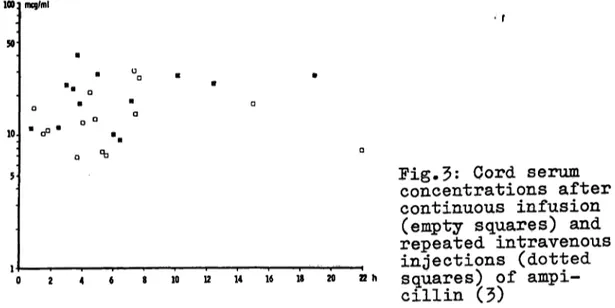38
Antibiotic concentrations in the mother and the ;Cetus H. A. Hirsch
1. Pharmacokinetics
The transfer of antibiotics from the mother to the fetus in late pregnancy is mainly achieved through placental passage by simple diffusion. From the fetus, antibiotics pass into the amniotic fluid via fetal urine but also from fetal surfaces, umbilical cord and paraplacentally through the fetal membranes. Together with amniotic fluid they are swallowedf reabsorbed and retransferred to the mother via the placent .
2. Single injections
After a single i.v. or i.m. injection, a peak level is quickly reached in the maternal serum. Thereafter, while the maternal blood level decreases, the serum level in the fetus rises and then decreases but more slowly than in the mother. The calculation of a distribution ratio is meaning- less, since both concentrations are constantly changing.
The same is true for amniotic fluid levels. In order to evaluate the therapeutic activity of the intrauterine anti- biotic level, its absolute value has to be considered.
3. Continuous intravenous infusion
After a loading dose and during continuous intravenous in<-
mcg/ml MIC 50
10-
5 -
2 .
l
_ Baderoides
""" Proteussp/
— E. coli
• maternal serum D cord serum Δ amniotic fluid
8 τ
10
yEnterococci /,Staph. aureus /OStreptococci 12
Pig.1: Maternal serum, cord serum and amniotic fluid con- centrations during continuous infusion of 1g ampicillin/h in comparison to'the MIO1s of the most common pathogens of intra-uterine infections (3)·
0300-5577/81/0091-0009 S 2.00 Copyright by Walter de Gruyter & Co.
39 fusion of an antibiotic, a steady state is established in maternal serum. This allows a better study of intrauterine
transfer and comes closer to the clinical Situation in which usually more than one single dose is injected (1i2f3f4·).
During the steady state of ampicillin (Fig. 1) cord serum levels of about 50% of the maternal serum levels are
reached within less than one hour (3). Amniotic fluid levels rise constantly and reach a plateau after about 8 hours.
Differences in the time necessary to reach a constant fetal serum or amniotic fluid level seem to correlate vrith the degree of protein binding of the antibiotic (5).
4-. Repeated intravenous injections
During repeated intravenous injections of the same amount of the antibiotic per time, the maternal level zigzags around a mean comparable to the corresponding steady state level (Fig. 2). The fetal serum levels (Fig. 3) and the amniotic fluid levels are comparable to the ones achieved during continuous infusion (3)·
MIC50
5 -
O maternal serum A amniotic fluid B cord serum
— Bacteroides
""Proteussp.
-E. coli terococci :aph. aureus
reptococci
1.5J 10 12
Fig.2: Maternal serum? cord serum and amniotic fluid concentrations after intravenous injections of 2g ampi- cillin every 2 hours, in comparison to the MC1s of the most common pathogens of intrauterine infections (3)·
5. Therapeutic activity
When high doses of ampicillin (3)* ticarcillin (1)? cepha- cetril Q^)f or gentamicin (2) are givenf therapeutic con- centrations are reached in both fetal serum and amniotic fluid levels (Tab. 1).
1001 mg/ml 50
Fig.3: Cord serum concentrations after continuous Infusion
(empty squares) and repeated intravenous injections (dotted
0 2 4 6 20 22h squares) of ampi-
cillin (3)
Table 1: Maternal serum and intrauterine concentrations of various antibiotics during a steady state in the mother,
Infusion
(sA)
Cephacetrile Ampicillin Ticaroillin Gentamicin References:
0.5 1.0 2.0 0.04
Maternal serum (mcg/ml) 2 8 - 3 4 20 - 30 130 - 220
4 - 5
Cordserum (mcg/ml)
12 12 90 3
- 25 - 22 - 115 - 4
Amniotic fluid
(mcg/ml) 9
25
4-0 4
- 14 - 30
- 90
- 5 1. BRUN DEL HEf R., U.HAJIiERj E.SCHMID, H.A.HIRSCH:
Materno-fetale Passage von Ticarcillin, Im: Dudenhausen, J.W., E.Saling, (Hrsg.): Perinatale Medizin, Bd. V,
Georg Thieme, Stuttgart 1974.
2. DAUBENZELD, P., H.MODDE, H.A.HIRSCH: Transfer of genta- micin to the fetus and the amniotic fluid during a steady state in the mother. Arch. Gynäkol. 217 (197*0 233.
3. HIRSCH, H.A., E.DREHER, A.PERROCHET, E.SCHMID: Transfer of ampicillin to the fetus and the amniotic fluid during a continuous infusion and single repeated intravenous in- jections to the mother. Infection 2 (1974·) 207.
4. HIRSCH, H.A., S. HERBST, R. LANG, A. GABLIETGER, L. DETTLI:
Transfer of a new cephalosporin antibiotic to the fetus and the amniotic fluid during a continuous infusion and single repeated intravenous injections to the mother. Arch. Gynäkol. 216 (1974) 1.
5. MacAULAY, M.A., M. ABOU-SABE, D. CHARLES: Placental trans- fer of ampicillin. Amer^ J. Obstet. Gynec. 96 (1966) 943
Prof.Dr.H.A.Hirsch Univ.-Frauenklinik Schleichstr.4
D-7^00 Tübingen/Germany
